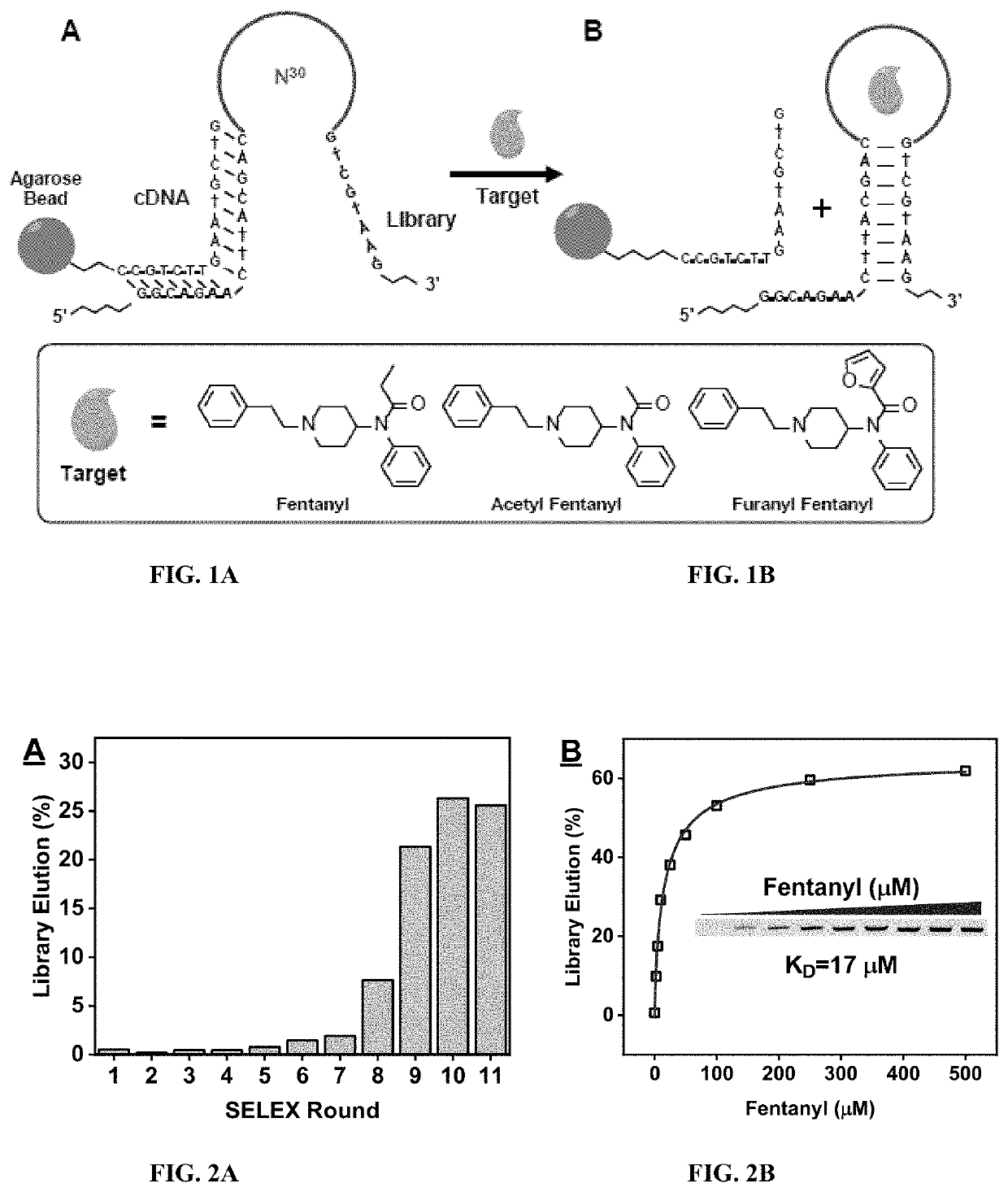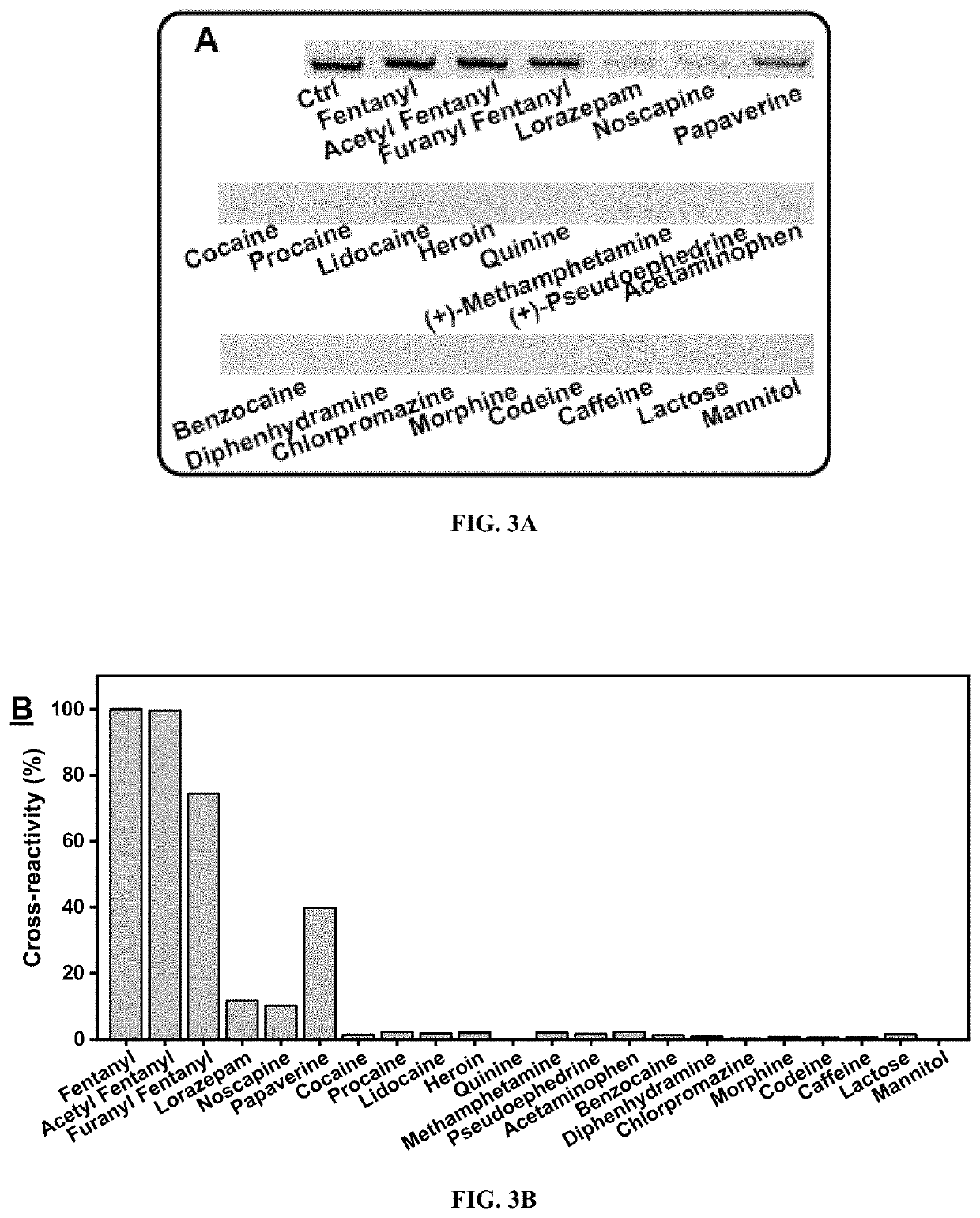Aptamer-based sensors for detection of fentanyl opioids
a technology of fentanyl opioids and sensors, which is applied in the field of aptamer-based sensors for detection of fentanyl opioids, can solve the problems of difficult generation of suitable bioreceptors, difficulty in detecting such family members of antibody-based immunoassays, and impairing the binding affinity of existing antibodies, so as to achieve rapid and sensitive detection, increase the current
- Summary
- Abstract
- Description
- Claims
- Application Information
AI Technical Summary
Benefits of technology
Problems solved by technology
Method used
Image
Examples
example 1
Strategy and Conditions
[0180]To isolate a high-affinity aptamer which is cross reactive to fentanyl and its analogs, selection against three fentanyl family members: Fentanyl, Acetyl fentanyl, and Furanyl fentanyl was performed by using a library-immobilized SELEX technique with a structured library design (FIG. 1). The library pool possesses a 30-nucleotide (nt) random region (FIG. 1, N30) and constant regions composed of two primer binding sites and an 8-nt complementary stem (FIG. 1). The library was hybridized to a biotin-modified 15-base pair (bp) complementary DNA (bio-cDNA) (FIG. 1) which was immobilized onto streptavidin-coated agarose beads via streptavidin-biotin interaction (FIG. 1A). After immobilization of the library pool to the beads, the modified beads were washed with selection buffer to remove library strands which spontaneously elute from the column. A solution of fentanyl or its analogs was then flowed through the column. Aptamer binding to the target dissociated...
example 2
SELEX
[0186]The enrichment of fentanyl-binding aptamers was monitored using a gel elution assay. Between selection rounds of 1-7 there was little to no change in the amount of library strands which were eluted by fentanyl from the beads (FIG. 2A, <2%), indicating that fentanyl-binding aptamers have yet to be enriched. During rounds 8 and 9 there was an exponential increase in the fentanyl-eluted library (FIG. 2A). This indicates that the fentanyl-binding aptamers have begun to be enriched. Saturation of enrichment was observed during rounds 10 and 11 (FIG. 2A). Throughout rounds 8-11, the concentration of fentanyl used for elution was reduced from 100 to 50 μM to rapidly enrich high-affinity fentanyl-binding aptamers (Table 2).
[0187]A gel elution assay was performed to characterize the binding properties of the round 11 fentanyl pool. The binding affinity of the round 11 pool was first determined by challenging library-immobilized beads against a variety of fentanyl concentrations an...
example 3
ntanyl SELEX
[0188]Based on the results of the fentanyl SELEX, the SELEX procedure was modified for acetyl fentanyl. Specifically, between rounds 1-6, a steady increase was observed in the eluted library strands by acetyl fentanyl (FIG. 4A). Counter SELEX was started from round 5 to remove nonspecific aptamers against lorazepam, noscapine, and papaverine. During rounds 7 and 8 there was an exponential increase in the quantity of eluted library strands with saturation of pool enrichment from rounds 9 to 10 (FIG. 4A). Throughout rounds 7-10 the acetyl fentanyl concentration was reduced from 200 to 50 μM to increase the SELEX stringency for isolating high-affinity acetyl fentanyl-binding aptamers (Table 3).
[0189]The binding affinity and cross reactivity of the round 10 acetyl fentanyl pool was then characterized using the gel elution assay. The pool affinity was determined to be 15 μM (FIG. 4B). Moderate cross-reactivities of 81% and 64% for 25 μM fentanyl and 25 μM furanyl fentanyl, re...
PUM
 Login to View More
Login to View More Abstract
Description
Claims
Application Information
 Login to View More
Login to View More - R&D
- Intellectual Property
- Life Sciences
- Materials
- Tech Scout
- Unparalleled Data Quality
- Higher Quality Content
- 60% Fewer Hallucinations
Browse by: Latest US Patents, China's latest patents, Technical Efficacy Thesaurus, Application Domain, Technology Topic, Popular Technical Reports.
© 2025 PatSnap. All rights reserved.Legal|Privacy policy|Modern Slavery Act Transparency Statement|Sitemap|About US| Contact US: help@patsnap.com



